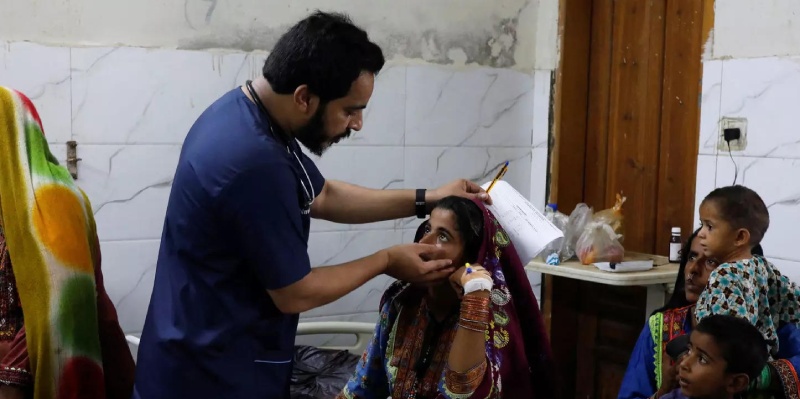It’s a ‘second disaster’ in Pakistan after floods as water-borne illnesses spread

Pakistan Floods: In some areas, it may take two to six months for stagnant floodwaters to subside after covering hundreds of square miles (km).
In Sehwan, a small town in southern Pakistan, there are too many patients for the emergency ward, which is overcrowded.
Hundreds of patients were crowded into rooms and hallways during a recent visit by Reuters as they desperately sought medical attention for diseases like malaria and others that are rapidly spreading as a result of the nation’s worst floods in decades.
Naveed Ahmed, a young physician working in the Abdullah Shah Institute of Health Sciences’ emergency response division, is being hounded by five or six people amid the chaos.
The 30-year-old maintains his composure as overburdened emergency services struggle to handle the tens of thousands of patients who are arriving from kilometres away after their homes were swamped under water during the August and September rains.
During a brief break, Ahmed told Reuters while sipping tea in the hospital canteen, “We become so overworked at times that I feel like collapsing and going on an intravenous drip.”
“However, we continue because of the prayers of these sufferers.”
Ahmed is fighting to reduce illness and fatalities in southern Pakistan, where hundreds of towns and villages have been cut off by swollen rivers. In a nation of 220 million, the deluge has touched almost 33 million people.
Although Ahmed worries that other ailments will become more prevalent as winter approaches, the majority of the 300–400 patients who arrive at his clinic each morning, many of whom are youngsters, are suffering from malaria and diarrhoea.
He remarked, “I hope people who have been affected by the floods can return to their homes before winter; (if not,) they would be vulnerable to respiratory ailments and pneumonia living in tents.
Thousands of Pakistanis who fled their houses are now living in government-established camps for them or in the open.
Stagnant floodwaters have already caused widespread cases of skin and eye infections, diarrhoea, malaria, typhoid, and dengue fever. In some regions, it may take two to six months for the floodwaters to subside.
Pakistan is particularly hard-hit by the crisis at this time. It lacks the capacity to deal with the longer-term repercussions of the flooding since its economy is in turmoil and is being supported by loans from the International Monetary Fund.
Because of the floods brought on by the strong monsoon rains and melting glaciers, about 1,700 people have died. The government and UN have placed the responsibility for the disaster on climate change, with Pakistan placing the cost of the destruction at $30 billion.
According to authorities, diseases brought on by the floods have claimed the lives of almost 340 people.
Second disaster
Since July 1, 17,285 cases of malaria have been confirmed, according to the health department of Sindh Province, the area that has been most severely impacted.
The Sindh government is attempting to temporarily engage more than 5,000 health specialists in the most vulnerable districts as a precaution against the possibility of disease epidemics following the rescue and relief phase of the floods.
As a result of the exceptional rains and floods, the Sindh government’s parliamentary health secretary, Qasim Soomro, told Reuters, “We are short of human resources considering the scale of the burden of disease.”
The World Health Organization (WHO) is alarmed about the possibility of a “second tragedy” brought on by the development of water-borne illnesses throughout the nation, particularly in Sindh.
A young man in the Sehwan hospital ward was experiencing fits on a bed outside the main emergency room while suffering from a high temperature. His mother rushed to Ahmed, who responded to the patient and requested that a male nurse apply ice to his forehead.
There weren’t enough air conditioners to keep the hot, humid air in the halls lined with mattresses since there were too many people and beds. The wards were completely occupied, and a few of the beds had multiple patients in them.
Ahmed, a recent graduate of a Chinese institution, spoke about the pressure medics like him were working under.
He added that he started giving patients medicine after saying, “With such influx, we… cannot wait for test results for each patient to start the therapy.”
People from nearby towns and regions, including those staying in camps until the waters subside and reconstruction can start, are served by the Sehwan Institute.
After developing a fever around a week earlier, Jagan Shahani’s daughter passed out. He hailed down a car on the neighbouring road that would take them to Sehwan after using a boat to escape his waterlogged hamlet of Bhajara.
Late last week, he continued, “Doctors said she had malaria. “We have spent our fourth night here. There is nothing to eat here, but Allah has been incredibly generous in providing everything “Shahani, whose 15-year-old daughter Hameeda is now making a full recovery, remarked.